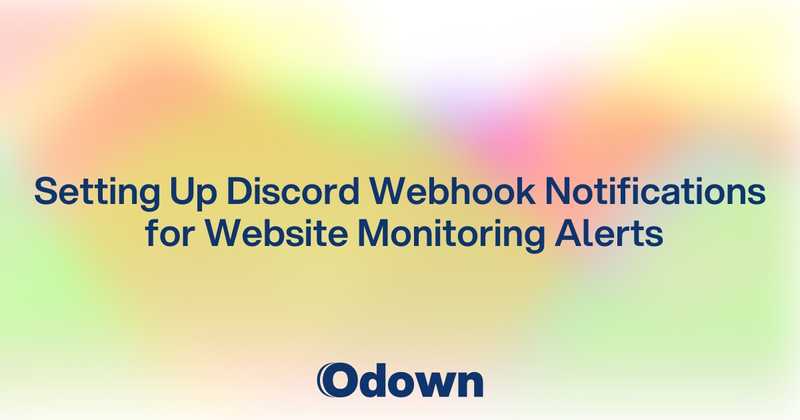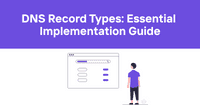Setting Up Discord Webhook Notifications for Website Monitoring Alerts
Communication during outages and incidents is critical, and Discord has become a popular platform for team collaboration. Setting up effective monitoring notifications through Discord webhooks ensures your team stays informed about website issues, downtime, and performance problems. This integration guide walks through the complete process of connecting your monitoring system to Discord.
Discord webhooks provide a simple way to send automated messages to your team channels. When configured properly, these notifications help reduce response time, improve team coordination, and maintain visibility into system health. The right alert configuration transforms Discord from a communication tool into a central component of your incident management strategy.
Creating and Configuring Discord Webhooks for Alerts
Setting up Discord webhooks requires configuration on both the Discord side and your monitoring platform:
Step 1: Create a Discord Webhook
- Open Discord and navigate to the server where you want to receive alerts
- Select a channel or create a dedicated
#alertschannel
- Right-click the channel name and select "Edit Channel"
- Go to the "Integrations" tab
- Click "Create Webhook"
- Give your webhook a descriptive name (e.g., "Website Monitoring Alerts")
- Optionally, customize the avatar (consider using your monitoring tool's logo)
- Click "Copy Webhook URL" - this is the endpoint you'll use to send alerts
- Click "Save" to create the webhook
Webhook Security Best Practices:
- Treat webhook URLs as sensitive credentials
- Never post them publicly or commit them to code repositories
- Rotate webhook URLs if suspected compromised
- Use dedicated webhooks for different monitoring systems
Step 2: Configure Odown for Discord Notifications
- Log into your Odown dashboard
- Navigate to "Notification Settings" under your account
- Select "Add New Integration"
- Choose "Discord" from the integration options
- Paste your Discord webhook URL
Configure the notification settings:
- Alert types (outages, performance, SSL issues, etc.)
- Threshold for triggering alerts
- Alert format preference
Discord-Specific Settings:
- Select which alert types send to Discord vs. other channels
- Configure alert severity thresholds
- Set up custom message templates
- Enable/disable alert images and graphics
Role-Based Alert Routing
Discord's role mention system can be leveraged for proper alert escalation:
Setting Up Team Roles:
Create specific roles in Discord for different responsibilities:
@on-call
@database-team
@frontend-team
@security-team
Configure different webhooks for different alert types:
- Critical alerts mention
@on-call
- Database alerts mention
@database-team
- Frontend alerts mention
@frontend-team
- SSL/security alerts mention
@security-team
Alert Routing Configuration:
"alerts": {
"critical": {
"mention": "<@&ROLE_ID_ON_CALL>",
"color": 15158332,
"title": "CRITICAL ALERT"
},
"warning": {
"mention": null,
"color": 16776960,
"title": "Warning"
},
"info": {
"mention": null,
"color": 3066993,
"title": "Info"
}
}
}
Note: Replace ROLE_ID_ON_CALL with your actual Discord role ID.
Customizing Alert Formats and Triggers
Discord webhooks support rich message formatting to enhance alert visibility and effectiveness.
Rich Embed Message Formatting
Discord embeds allow for visually distinct and information-rich alerts.
Basic Embed Structure:
"embeds": [{
"title": "Website Down Alert",
"description": "The website is currently experiencing an outage",
"color": 15158332,
"fields": [{
"name": "Status",
"value": "DOWN",
"inline": true
}, {
"name": "Duration",
"value": "3 minutes",
"inline": true
}, {
"name": "Last Checked",
"value": "2023-04-25 15:30 UTC",
"inline": true
}],
"footer": {
"text": "Odown Monitoring"
},
"timestamp": "2023-04-25T15:30:00Z"
}]
}
Color Coding for Alert Types:
- Red (15158332): Critical issues/downtime
- Yellow (16776960): Warnings/performance issues
- Green (3066993): Recovery/resolved alerts
- Blue (3447003): Informational messages
When managing incidents across regions like India, appropriate geographic monitoring considerations become essential for accurate alerting and true problem identification. See Article 15: Website Monitoring Solutions for Indian Businesses.
Alert Message Components
Effective Discord alerts include these key elements:
Critical Information Elements:
- Alert type and severity
- Affected system/endpoint
- Error type or HTTP status
- Timestamp of occurrence
- Duration (for ongoing issues)
- Monitoring location
- Link to details dashboard
Example Alert Message Template:
Status: {status}
Error: {error_message}
Location: {location}
Time: {timestamp}
[View Details] ({dashboard_url})
Alert Throttling and Aggregation
Prevent Discord channel flooding with intelligent alert handling.
Alert Throttling Strategies:
- Aggregate similar alerts within a timeframe
- Set minimum time between successive alerts
- Group alerts from the same systems
- Use escalating notification intervals
- Implement intelligent alert suppression
Sample Throttling Configuration:
"throttling": {
"similar_alerts": {
"window_seconds": 300,
"max_count": 3,
"aggregate": true
},
"rate_limit": {
"max_per_minute": 5,
"burst_allowance": 10
}
}
}
Advanced Discord Integration Techniques
Creating Alert Workflows with Buttons
Discord supports interactive buttons for incident response.
Button Actions Example:
"content": "Website is experiencing high error rates",
"components": [
{
"type": 1,
"components": [
{
"type": 2,
"style": 4,
"label": "Acknowledge",
"custom_id": "ack_alert"
},
{
"type": 2,
"style": 1,
"label": "View Details",
"url": "https://dashboard.odown.com/ incidents/12345"
}
]
}
]
}
Note: Button interactions require a bot application, not just webhooks.
Incident Command Center in Discord
Turn Discord into a complete incident command center.
Recommended Channel Structure:
#alerts: Automated notifications only
#incidents-active: Ongoing incident coordination
#incidents-resolved: Archived incident threads
#post-mortems: Analysis and learnings
#monitoring-chat: General monitoring discussion
Incident Workflow:
- Alert appears in
#alerts - On-call creates thread in
#incidents-active - Team collaborates in the thread
- Upon resolution, thread is moved to
#incidents-resolved - Post-mortem created in
#post-mortems
Integration with Discord Bots
Extending beyond simple webhooks with custom Discord bots.
Bot Enhancement Options:
- Interactive commands to check system status
- Historical data retrieval within Discord
- Alert acknowledgment tracking
- Escalation management
- Incident timer tracking
- Automatic post-mortem generation
Sample Bot Command Interface:
/alert history 24h
/acknowledge incident-1234
/escalate incident-1234 @DevOps
/timer start incident-1234
Practical Discord Alert Implementation
Example: Multi-Tier Alert System
Alert Tier Structure:
- P1 - Critical: @everyone mention, red embed, dedicated channel
- P2 - Urgent: @on-call mention, orange embed, main alerts channel
- P3 - Warning: No mention, yellow embed, main alerts channel
- P4 - Info: No mention, blue embed, secondary channel
Use Case Mapping:
- P1: Service downtime, payment failures
- P2: API errors, performance drops
- P3: Latency issues, minor functionality drops
- P4: Deployments, scheduled maintenance
Sample Alert Messages for Different Scenarios
Downtime Alert:
**Status:** 503 Service Unavailable
**Duration:** 3m 45s and counting
**Affected URLs:** https://example.com/*
**Location:** 4/5 monitoring locations reporting
Last check: 2023-05-15 14:32:15 UTC
Performance Alert:
Status: Degraded Performance
Response Time: 3452ms (threshold: 2000ms)
Affected Component: API Endpoint /users
Pattern: Gradually increasing over past 30 minutes
Last check: 2023-05-15 13:15:42 UTC
Recovery Alert:
Status: 200 OK
Downtime Duration: 17m 23s
Root Cause: Database connection pool exhaustion
Recovery Action: Auto-scaling triggered
All monitoring stations reporting normal operation.
Implementing Discord Alerts for Common Scenarios
Website Downtime Alerts
Key Information Elements:
- HTTP status code detected
- Error screenshot (if available)
- Response headers
- Historical uptime context
- Geographic spread of the issue
Alert Frequency:
- Initial alert immediately
- Updates every 5 minutes for first 15 minutes
- Updates every 15 minutes thereafter
- Immediate recovery notification
Performance Degradation Alerts
Threshold Configuration:
- Warning: Response time 50% above baseline
- Critical: Response time 100% above baseline or above 3 seconds
- Sustained: Issues persisting for 3+ consecutive checks
Alert Contents:
- Response time graph (if possible)
- Comparison to baseline
- User impact estimation
- Potential bottleneck identification
SSL Certificate Monitoring
Certificate Alerts:
- Expiration warnings (30, 14, 7, 3, 1 days before)
- Certificate validation failures
- Cipher suite vulnerabilities
- Chain verification issues
Alert Message Example:
Domain: example.com
Expiration: 14 days remaining (June 15, 2023)
Issuer: Let's Encrypt Authority X3
Action Required: Renewal needed before June 15
[Renewal Instructions Link]
Team Workflow Best Practices
Effective team response requires more than just technical alerting.
Alert Response Protocol
Standardized Response Procedure:
- First responder acknowledges alert in Discord
- Initial assessment shared within 5 minutes
- Regular updates every 15 minutes
- Clear ownership assignment in thread
- Resolution and follow-up actions documented
Response Acknowledgment:
- React with 👀 when investigating
- React with 🔄 when working on resolution
- React with ✅ when resolved
- Create thread for extended discussion
Handling After-Hours Alerts
Off-Hours Protocol:
- Restrict @mentions to true emergencies
- Use escalation paths defined in Discord roles
- Implement follow-the-sun rotation for global teams
- Document clear criteria for wake-up calls
- Track incident response time by hour/day
Escalation Time Windows:
- Business hours: 15-minute response
- Evening hours: 30-minute response
- Overnight: 60-minute response for non-critical
- 24/7 response for business-critical systems
Alert Fatigue Prevention
Reducing Notification Noise:
- Implement proper alert thresholds
- Use different channels for different severity levels
- Create daily digest for low-priority items
- Review and tune alert frequency regularly
- Disable alerts during maintenance windows
Measuring Alert Effectiveness
Track and improve your alerting system over time.
Key Metrics to Monitor
Alert System Effectiveness:
- False positive rate
- Mean time to acknowledge
- Alert-to-incident ratio
- Channel noise level
- Team response rate
Regular Optimization:
- Monthly review of alert patterns
- Tuning of thresholds based on data
- Alert template refinements
- Channel structure adjustments
- Role and mention optimization
Feedback Mechanisms
Continuous Improvement:
- Regular team surveys on alert usefulness
- "Rate this alert" reaction system
- Periodic review of ignored alerts
- Documentation of alert evolution
- Cross-team alert standardization
Discord webhook integration transforms monitoring alerts from emails that might be missed into highly visible, actionable information. The rich formatting capabilities and channel organization options make Discord an excellent platform for team notification and incident coordination.



